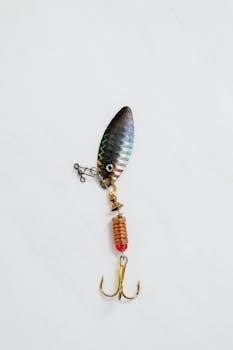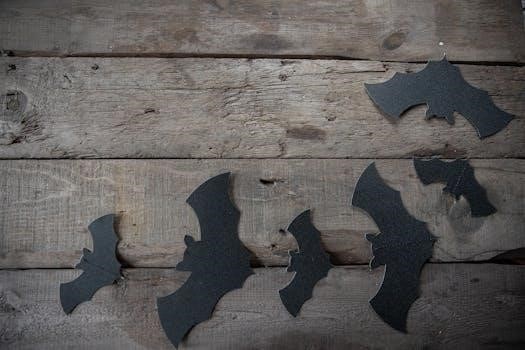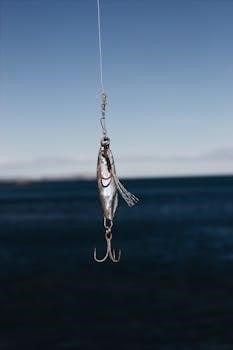
fishing hook size chart actual size pdf
Understanding Fishing Hook Sizes
Navigating the world of fishing hooks can be tricky․ Sizes are indicated by numbers, but the system can be confusing, so understanding the basics is key․ We’ll explore the general sizing system and hook anatomy․
General Hook Size Numbering System
Fishing hook sizes use a numerical system that can seem counterintuitive․ Smaller numbers represent larger hooks, while larger numbers denote smaller hooks․ For instance, a size 1 hook is significantly larger than a size 10 hook․ Sizes range from very small, like size 32 used for tiny flies, to very large, like 19/0 used for massive saltwater game fish․ The system isn’t standardized across all manufacturers, leading to slight variations in actual dimensions, but it is a general guide․ This system is used with most types of hooks, including circle hooks, treble hooks, and single hooks, so understanding it is essential for every angler․ It is important to be aware that this system is not the same as hook dimensions in inches or millimeters․
Hook Anatomy⁚ Key Parts
Understanding the anatomy of a fishing hook is essential for effective angling․ The key parts include the eye, which is the loop at the top for attaching the line․ The shank is the straight portion of the hook, which connects the eye to the bend․ The bend is the curved area of the hook․ The gap is the distance between the point and the shank․ The point is the sharp end of the hook that penetrates the fish’s mouth․ Finally, the barb is the small projection near the point that prevents the hook from easily slipping out․ Each of these parts contributes to the hook’s overall functionality and effectiveness․

Hook Size Charts and Resources
Finding the right hook size can be easier with charts and guides․ These resources will assist you with printable charts, bead sizing, and fly tying hook charts;
Printable Hook Size Charts
Anglers often seek printable hook size charts for easy reference․ These charts, sometimes available as PDFs, can be a handy tool in your tackle box, offering actual-size representations of various hook sizes․ Many online resources offer these printable charts, allowing you to compare hooks visually․ These actual size charts are especially helpful when you need to match a new hook to an existing one or when choosing the right size for a specific fishing situation․ Some resources provide ․jpg images that can be saved, while others offer printable PDFs․ These resources can be invaluable for anglers, whether they are beginners or seasoned veterans․ Using a printable chart helps with accuracy, making the selection process simpler․
Bead to Hook Sizing Charts
Fly tying often requires matching beads to hooks, making bead-to-hook sizing charts essential․ These charts, sometimes called fly tying bead hook charts, guide anglers in selecting the correct bead size for a given hook size․ They often display hook sizes alongside corresponding bead and cone sizes, helping simplify the process․ It can be difficult to remember which size bead matches a specific hook size, which is why these charts are so helpful․ Keep in mind that the fit may vary with hook style․ Wider gape hooks, for example, will generally allow for a larger bead size than a standard hook․ Using these charts ensures a proper fit․
Fly Tying Hook Sizing Charts
Fly tying hook sizing charts are crucial for fly anglers․ The hook determines the basic size and shape of each fly․ Finding a printable fly fishing hook size chart can be challenging․ These charts offer detailed measurements for various hook sizes, which is essential for fly tiers․ They help ensure accurate fly construction, as they allow anglers to choose the correct hook size for their specific patterns․ Additionally, these charts often include information on hook types, such as those used for salmon eggs or other specific fly patterns, and often include hook anatomy․ Using these charts can greatly improve your fly tying․

Hook Selection Based on Target Fish
Selecting the correct hook size depends greatly on the fish you’re targeting․ Different species require different hook sizes, both in freshwater and saltwater․ It’s essential to match your hook to your prey․
Freshwater Game Fish Hook Sizes
When targeting freshwater game fish, hook size selection is crucial for success․ For panfish like crappie and bluegill, smaller hooks, often in sizes 6 to 10, are ideal, as these fish have smaller mouths․ Bass fishing often requires larger hooks, ranging from 1/0 to 5/0, depending on the bait and size of the fish․ Trout anglers typically use sizes 8 to 14, but this can vary depending on the type of trout and the presentation․ Remember, using a hook too large can reduce your chances of hooking smaller fish, while a hook that is too small can lead to lost fish․ Always consider the size of the bait you are using as well as the size of the fish you expect to catch․ Always be sure to check local regulations as well․
Saltwater Game Fish Hook Sizes
Selecting the correct hook size for saltwater game fish is vital for success, as these species vary greatly in size and feeding habits․ Smaller saltwater fish like snapper and sea bass often require hooks in the range of size 2 to 4/0․ For larger species such as tuna, marlin, and sailfish, much larger hooks are necessary, typically ranging from 6/0 to 12/0 or even larger․ The type of bait used also plays a crucial role in determining the right hook size․ When using live bait, the hook should be sized appropriately to allow the bait to swim naturally․ Remember to consider the fish’s mouth size and feeding style when making your selection․ Always check local fishing regulations for any size restrictions․

Hook Material and Quality
The materials used in hook construction greatly impact their strength and durability․ High carbon steel is often preferred for its strength, while brands like Mustad ensure consistent quality and reliability․
High Carbon Steel Hooks
High carbon steel hooks are a popular choice among anglers due to their exceptional strength and durability․ This material allows hooks to maintain a sharp point for a longer period, ensuring better hooksets․ The strength of high carbon steel is critical when battling larger fish, reducing the chances of hook failure or bending․ These hooks are typically more resistant to corrosion than standard steel hooks, offering a longer lifespan․ Many manufacturers treat high carbon steel with special coatings to further enhance their resistance to rust and wear․ This material is essential for anglers seeking reliable, long-lasting hooks that can handle various fishing conditions and species, providing confidence when battling any fish․ It is a cornerstone of quality in fishing tackle․
Mustad Hook Quality
Mustad hooks are renowned for their commitment to quality and reliability in the fishing industry․ They employ rigorous testing and quality control measures to ensure their hooks meet the highest standards, providing anglers with the best possible experience on the water․ Mustad utilizes advanced technology and premium materials to create hooks that are strong, sharp, and durable․ This focus on quality translates to better hooksets and fewer missed opportunities․ The brand’s dedication to innovation and quality has earned them the trust of anglers worldwide, making Mustad a go-to choice for fishing hooks․ The consistency in their manufacturing processes ensures that each hook provides the same level of performance, giving anglers confidence when battling any size fish․

Additional Factors in Hook Choice
Selecting the right hook involves more than just size․ We must consider hook style and shape, and local angler tips often provide invaluable insights for specific fishing conditions․
Hook Style and Shape
Beyond size, the style and shape of a fishing hook play crucial roles in its effectiveness․ Different hook designs are tailored for various fishing techniques and bait types․ For instance, circle hooks are designed to hook fish in the corner of the mouth, while O’Shaughnessy hooks are often used for spinnerbaits and trailer hooks․ The bend, point, and barb of the hook all contribute to its holding power and the ease with which it can penetrate a fish’s mouth․ Understanding how these factors interact with your bait and target species will help you make informed choices․ Consider the gape, the distance between the hook’s point and shank, which impacts how well it can set․ The right hook shape ensures a better hook-up ratio and reduces the chance of losing fish․
Local Angler Tips on Hook Size
While charts provide a general guideline, local anglers often have invaluable insights into hook sizes that work best in specific areas․ Their experience fishing the same waters consistently can reveal nuances not captured in standard sizing recommendations․ Talking to anglers at local tackle shops or on the water can give you practical advice on what hook sizes are most effective for the particular fish species and conditions you’re facing․ They may suggest specific styles or shapes that have proven successful, or offer tips on adapting to certain bait types․ These tips, grounded in real-world experience, can be significantly more helpful than generalized charts alone, leading to greater fishing success․

Leave a Reply
You must be logged in to post a comment.